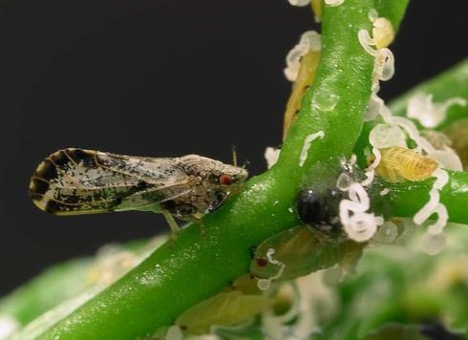The Asian Citrus Psyllid (ACP) is a small, aphid-sized insect that poses a serious threat to California's citrus trees. This invasive pest can carry and transmit a fatal bacterial disease called Huanglongbing (HLB) to all citrus species. HLB has already decimated citrus groves throughout Florida, costing the citrus industry millions of dollars. The psyllid is currently present in Southern California, but preventative measures can keep the disease and insect from spreading to California's citrus growing regions.
What does the Asian citrus psyllid look like?
Asian citrus psyllid adults are 1/6 to 1/8 inch long with brown wings and red eyes. They feed on plants at a 45-degree angle, with their heads down and back end in the air, unlike any other citrus pest. Their feeding causes twisted or distorted leaves. Nymphs are wingless, flattened, orange to brownish, and are generally found on young leaves and shoots. Both adults and nymphs feed on plant sap and excrete honeydew, but nymphs produce distinct waxy tubules to help clear the sugary waste from their bodies.
What are the symptoms of Huanglongbing disease?
An early symptom of HLB is irregular yellowing of leaves, on an individual limb or in one sector of a tree's canopy. Yellowed leaves are blotchy or mottled, but not symmetrically yellow like a nutrient deficiency. As the disease progresses, the fruit will become smaller, more bitter, and may not ripen properly. Once trees are infected, it may take up to two years for obvious symptoms to occur and trees can die within 5-10 years.
What can you do about the Asian citrus psyllid and Huanglongbing disease?
It is estimated that 6 out of every 10 California residences have at least one citrus tree on the property. Inspecting your own citrus trees is vital to prevent the spread of ACP and HLB. Check your citrus trees for the Asian citrus psyllid, especially in spring and fall when new growth is abundant. If you think you have found ACP or suspect HLB infection, contact the CDFA Exotic Pest Hotline at 1-800-491-1899 or your local county agricultural commissioner.
To learn more about Asian citrus psyllid and Huanglongbing disease, see the UC IPM Pest Notes: Asian Citrus Psyllid and Huanglongbing Disease and view UC IPM's online training.
